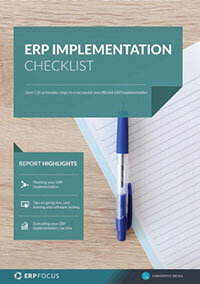The value of organizational change management (OCM) in ERP
ERP projects represent significant change for organizations. They are high risk, high-value initiatives, and often are scrutinized heavily. How well organizations prepare for the change and how it will impact the people, is a significant predictor of success. While ERP projects are often heavily supported by IT, ERP projects should be viewed as business investments and led by the functional workstreams.
ERP success criteria
Although ERP initiatives come in many forms (e.g. organizational-wide transformations, “BIG T”; selected adoption of new functionality within a business unit, “little t”; or a technology upgrade, “lift and shift”) success can be defined similarly:
- Meeting the objectives as outlined in the business case, charter, and/or statement of work
- Delivering the defined scope on time, within budget, and with an acceptable degree of quality resulting in minimal defects after cutover
- High levels of user adoption
- Sustained stakeholder satisfaction
The above success criteria are highly dependent on people, processes, and technology. To successfully manage the change associated with ERP projects the executive sponsor needs to be actively engaged and focus the people aspect by consistently embracing change, engaging the stakeholders impacted by the initiative, and creating a kaizen culture. Prosci®, the global leader in organizational change management best practice research, found that the number one success indicator of project success is an active and visible sponsor. Conversely, Prosci research shows that the number one indicator of project failure is the lack of active and visible sponsorship. Sponsors and leaders are extremely important during times of change. As described in The Progress Principle, the best leaders are able to build high performing teams who have great inner work lives. Author and American academic Teresa Amabile outlines how forward momentum in meaningful work-progress creates the best inner work lives for employees, described as having consistently positive emotions; strong motivation; and favorable perceptions of the organization, their work, and their colleagues.
Check out our free guide to ERP change management to learn more
According to a study by the Project Management Institute, Organizational Change Management continues to be a point of weakness for the majority of organizations. In their research, only 20 percent of organizations report their change management efforts are highly effective. The research also found that those with highly effective OCM practices “…are four times more likely to frequently use change management practices”, compared to those organizations with minimally effective change management practices. Prosci’s research shows that organizations that use a structured approach to managing the people side of change are six times more likely to achieve project results.
Tangible benefits
During times of change, there is always a dip in performance. This is a result of people unlearning the old way of working and learning the new way. Using effective organizational change management tactics won’t eliminate the performance dip, but it can minimize the dip and shorten the timeline to achieving the full ROI of the project.

Beyond effective project and requirements management, there are a number of ways organizations can improve and strengthen the value proposition and prevent those impacted most from being stuck in the “valley of despair” and minimize the period of disruption.
Below are four steps to consider for your next ERP project to help minimize disruption and maximize impact.
Step 1: conduct an OCM assessment and develop an OCM strategy
OCM strategies are often overlooked. They define the approach and the intent related to change management. Consistent, and often repetitive communication, is essential over the life cycle of an ERP implementation, which can often span multiple iterations. Leading practice is to start this exercise during the ideation phase. By waiting until the implementation phase, stakeholders will often feel left out, struggle to understand what’s in it for them, and will increase resistance to the effort. This starts with a comprehensive assessment of the stakeholders, anticipated change impacts, and organizational readiness. This information helps you to know how big and complex the change will be and how ready your organization is to make the transition. The information will inform your unique strategy to address your unique organizational culture.
Step 2: build an OCM plan
Using the OCM assessment and strategy information you should then develop an actual plan, or schedule, of activities that will be taken to prepare stakeholders to make the transition to the new way of working. The plan identifies who, what, when, and how you’ll reach the audiences. The focus of the plan is to help stakeholders be ready, willing, and able to adopt the change. The OCM plan can be managed via a matrix or checklist. Different channels can be considered to help increase readiness, willingness, and ability. To drive readiness, leverage communication vehicles such as: project kick-off, newsletters, videos, emails, and status reports. To drive willingness, use two-way tactics to allow for dialogue such as job impact workshops, roadshow demonstrations, town halls, and change agent networks. To drive ability, use a variety of training and knowledge transfer such as in-person training, eLearning modules, video walkthroughs, job aids, and informal support squads who can show ‘how’ to do a task.
During the planning exercises, the OCM team leads tend to build comprehensive and elaborate plans, only to later find they do not have sufficient resources to execute and monitor their effectiveness. Size your plan appropriately; consider for a moment a technology upgrade versus a “BIG T” transformation following a merger or acquisition. While the strategies could be similar, the plans may share very little in common.
Step 3: create an effective message
Research from the International Association of Business Communicators (IABC) shows that our communication at work uses too much jargon. There is an art to writing effective messages, and a reason authors have editors. Keep written messages simple, concise, and don’t complicate the intended message. For a moment, put yourself in the shoes of the stakeholder, as they participate in a session or read a newsletter again focus on addressing the WIIFM, “What’s in it for me”, this will capture the stakeholders’ attention.
Check out our ERP implementation plan for a 7 step methodology for implementing your system
When crafting an ERP session agenda or building a message, tailor the communication based on the stakeholder group, focused on the following elements:
- The intended audience, their interests, and motivation
- The stakeholder salience (power, legitimacy, and urgency)
- How do the stakeholders normally receive information?
- Start each session by telling the audience what they can expect to learn
- Conclude each session by restating the topics covered and asking if there are any questions
Step 4: monitor and measure the effectiveness of the OCM activities
The effectiveness of the OCM activities, as described by Prosci, can be measured across two outcome-oriented dimensions:
- Organizational performance e.g. did the initiative deliver on the value proposition?
- Individual performance e.g. where are employees on their change journey?
Starting with ideation, a structure should be established to monitor and measure the impact of the change and ensure that continued communication opportunities exist to build awareness, proficiencies, support, and adoption.
Conclusion
As described in Brené Brown’s Daring Greatly, as leaders we need to show up, let ourselves be seen, actively learn from our employees, inspire others, and be courageous. ERP projects create a unique opportunity for organizations to take risks, embrace vulnerabilities, and be daring. An effective approach to OCM will nourish employees and fuel their inner work life and positive progress by infusing their work with greater meaning during the ERP life cycle, starting with ideation. The success of the ERP initiative will heavily depend on taking a human-centered approach, by considering stakeholders, the possibilities of technology, and the five types of requirements for organization success. The human-centered approach also includes recognizing the contributions of others, encouraging people, providing emotional support, and developing bonds of mutual trust and appreciation.
Free white paper

ERP Implementation Checklist
Over 120 actionable steps to implementing a new ERP successfully

Related articles
-

Change management for ERP implementation: a case study
A real-world example of the benefits of weaving change management into the fabric of an ERP imple...
-

Secret KPI: Why Your ERP Implementation Team Matters More Than Software
Learn how Godlan ensures successful ERP implementation for manufacturers with proven strategies &...
-

Making you think: The struggle of changing habits
How to handle changing your employees' system habits when implementing a new ERP

